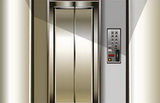Passenger Elevators
Although any working elevator has the capacity to move passengers up and down levels in a building, passenger elevators are designed specifically for the safety and comfort of the people riding them. They are also aesthetically more pleasing and have several features which cargo or industrial elevators don't always have. Passenger elevators range from simple stair lifts to large capacity commercial elevators and there are a variety of mechanisms which drive them. Common types of elevator systems are cable, hydraulic and pneumatic, and there are vertical elevators as well as passenger elevators on an incline.
Common Elevator Systems
Most passenger elevators are either cable or hydraulic operated systems. Both require electric to power the motor but hydraulic elevators use pressurized fluids to drive the car upwards while cable elevators are pulled upwards with a pulley mechanism and a rope/chain and lowered in like manner. Pneumatic elevators, also referred to as pneumatic vacuum elevators are operated by pressurized air in the chamber and usually carry lighter loads. While cable and hydraulic elevators can handle extremely large capacities, most pneumatic elevators are limited in the amount of weight they can safely handle. Pneumatic elevators are mostly made from plastic/glass so that passengers have a panoramic view while riding in the elevator.
Indoor and Outdoor Passenger Elevators
Elevators designed to carry passengers can be constructed both inside and outside a building. Quite often older buildings which weren't designed with elevators in the blueprints don't have space enough for an indoor elevator. When adding on to an existing structure, many older buildings have elevators attached at an exterior location where passengers can gain access to each floor from the outside elevator. Outdoor elevators are also used to move passengers up and down inclines such as mountains as in the case of ski lifts. However, elevators on an incline can also be constructed within a building as well. In actuality, escalators or people movers that are on an incline are a type of elevator as well. The only types of elevators that are difficult to add to an existing structure are those which require the motor room and mechanical works to be below ground. In those instances hydraulic elevators that require a deep area below ground level wouldn't be practical, but could be possible.
Most newer constructions that are multi-level buildings usually have elevators installed during the construction. However, when seeking to add an elevator to an existing structure or for outdoor use, there are a variety of sizes and types that could suit your purposes. By talking to a manufacturer or distributor about what you seek to accomplish and how much space you have available, passenger elevators can be designed to meet those specifications. Whether you are looking for domestic passenger elevators or commercial passenger elevators, your options are almost unending. It is simply a matter of matching the right type of passenger elevator with your needs.

